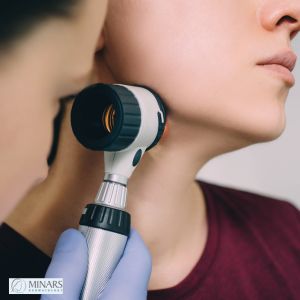 One of the most important steps in preventing and detecting skin cancer early is a thorough full-body skin exam. Many people are surprised to learn how many areas of their skin they can’t easily check on their own. As experienced dermatologists, we always recommend regular full-body exams because they allow us to identify suspicious lesions that might otherwise go unnoticed.
One of the most important steps in preventing and detecting skin cancer early is a thorough full-body skin exam. Many people are surprised to learn how many areas of their skin they can’t easily check on their own. As experienced dermatologists, we always recommend regular full-body exams because they allow us to identify suspicious lesions that might otherwise go unnoticed.
What Does a Full Body Skin Scan By a Dermatologist Involve?
During the exam, we carefully inspect your entire skin surface, from the top of your scalp all the way down to the soles of your feet. This includes areas that are often overlooked, such as:
- The scalp and behind the ears
- The back and shoulders
- The nails on both fingers and toes
- The groin and other less visible parts of the body
Since skin cancer can develop anywhere there is skin, including places you don’t see every day, a professional exam provides the most comprehensive check.
Why Is a Full Body Skin Cancer Screening Exam Important?
Some skin cancers, especially melanomas, can appear in hidden areas and may not cause any symptoms in the early stages. You might notice a mole on your arm but miss an abnormal spot on your back or scalp. A full-body skin exam ensures no suspicious lesion slips through the cracks.
The exam also serves as a baseline for future assessments. By documenting your skin’s current state, we can track changes over time. This is especially critical for patients who have a history of skin cancer or are at higher risk due to fair skin, excessive sun exposure, or family history.
How Often Should You Have a Skin Exam?
For people with no personal or family history of skin cancer, an annual full-body skin exam is typically sufficient. However, if you have had skin cancer before or have many risk factors, we recommend exams every six months or even more frequently. Regular visits allow us to catch new lesions early and intervene before they become advanced.
What Happens If We Find Something Suspicious?
If we discover a spot that looks unusual or concerning, the next step is usually a biopsy. This involves numbing the area and removing a small sample of skin tissue for laboratory analysis. The biopsy results guide the treatment plan, ensuring we address the problem appropriately.
If cancer is confirmed, treatment options depend on the type, size, and location of the lesion. Treatments range from simple removal procedures to specialized surgeries like Mohs micrographic surgery.
Early Detection Saves Lives
Skin cancer is one of the most common cancers, but also one of the most treatable when found early. A full-body skin exam is a vital tool in detecting skin cancers before they grow or spread. We encourage everyone to schedule regular skin checks and to be proactive about any new or changing spots on their skin.
Remember, you don’t have to wait for symptoms or visible changes to see a dermatologist. Prevention and early detection are your best defenses against skin cancer.









